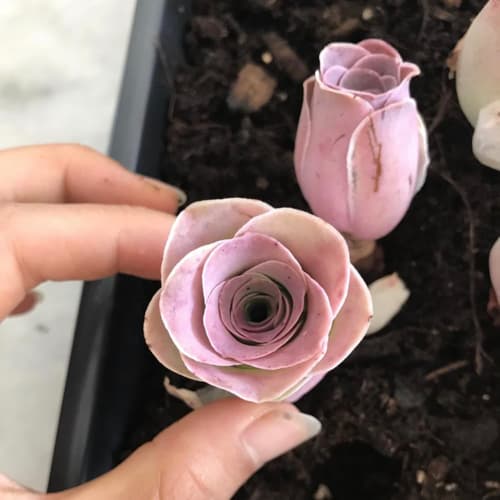Pseudolithos
Posted by Grace on October 31, 2023
Quick Facts
- Native Habitat: Areas of Somalia, Yemen and Oman
- Family: Asclepiadaceae
- Water: Low water requirements
- Sunlight: Thrives in bright, indirect light
- Soil: Well-draining soil mix
Contents
Why it is called Pseudolithos?
The name "Pseudolithos" is derived from the Greek words "pseudes," meaning false, and "lithos," meaning stone. This name is a testament to its deceptive appearance as it mimics the texture and color of stones, allowing it to blend into its natural habitat.
(The part "lithos" may also remind you of Lithops, another kind of succulent.)
Species
Pseudolithos come in various species, each with its unique characteristics. Some popular Pseudolithos species include:
- Pseudolithos migiurtinus
- Pseudolithos cubiformis
- Pseudolithos mccoyi
- Pseudolithos caput-viperae
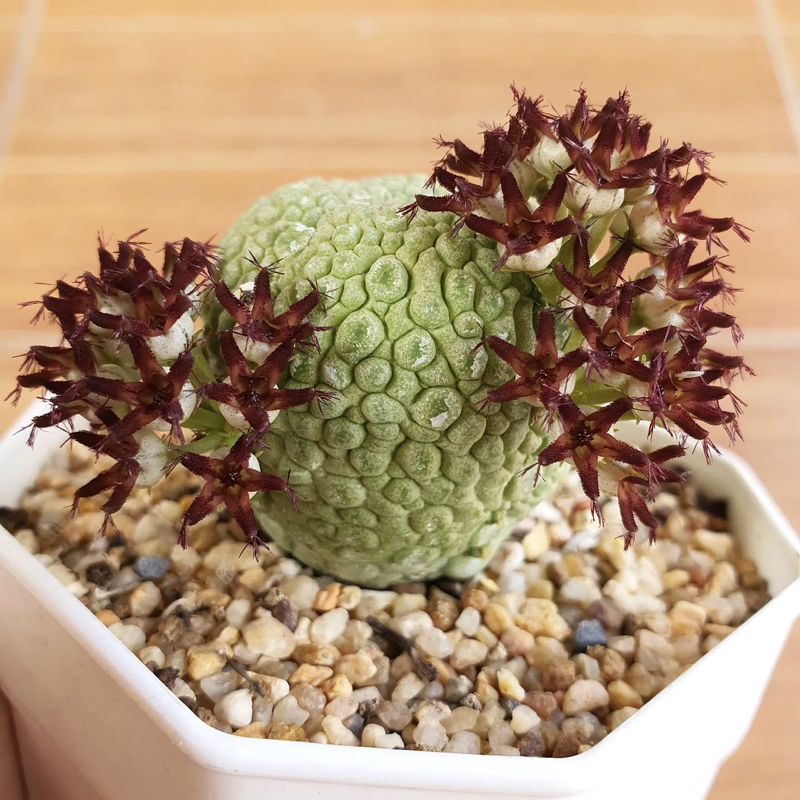 Pseudolithos migiurtinus (Source)
Pseudolithos migiurtinus (Source)
Pseudolithos migiurtinus is known for its small, compact growth habit. The plant typically consists of two or more conjoined, grey-green, stone-like bodies that can resemble rocks. These bodies have small tubercles, which add to the stone-like appearance.
Pseudolithos migiurtinus produces unique, star-shaped, maroon-colored flowers with a waxy texture.
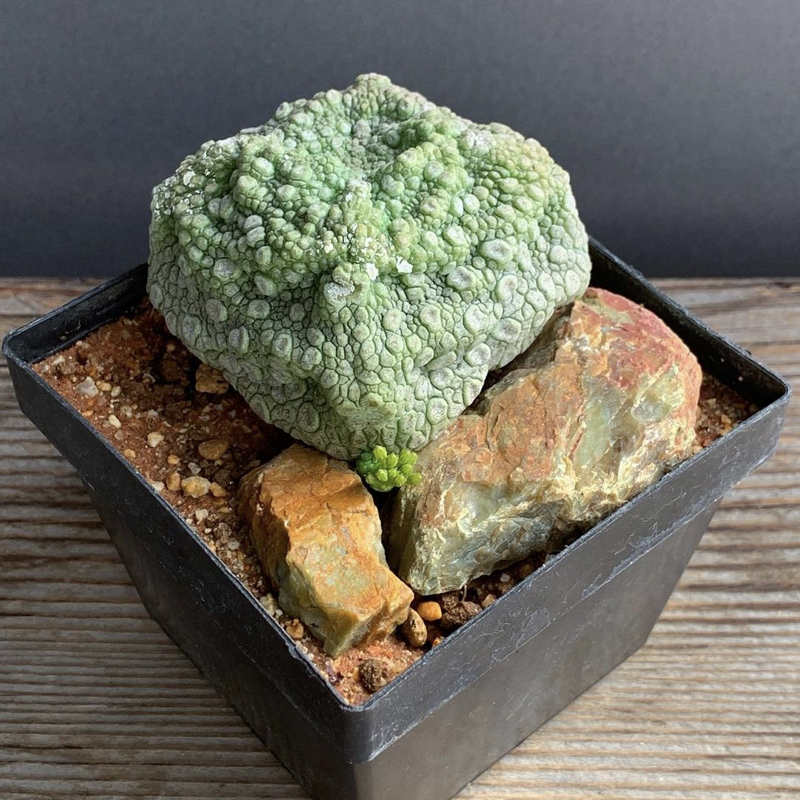 Pseudolithos cubiformis (Source)
Pseudolithos cubiformis (Source)
Pseudolithos cubiformis is recognized for its larger, cube-shaped bodies. The plant's bodies are generally larger and more cubic in shape than those of Pseudolithos migiurtinus. The color can range from greyish-green to brown, and they may have pronounced tubercles.
Similar to Pseudolithos migiurtinus, Pseudolithos cubiformis produces star-shaped flowers, but the flower color can vary from pale yellow to pale maroon.
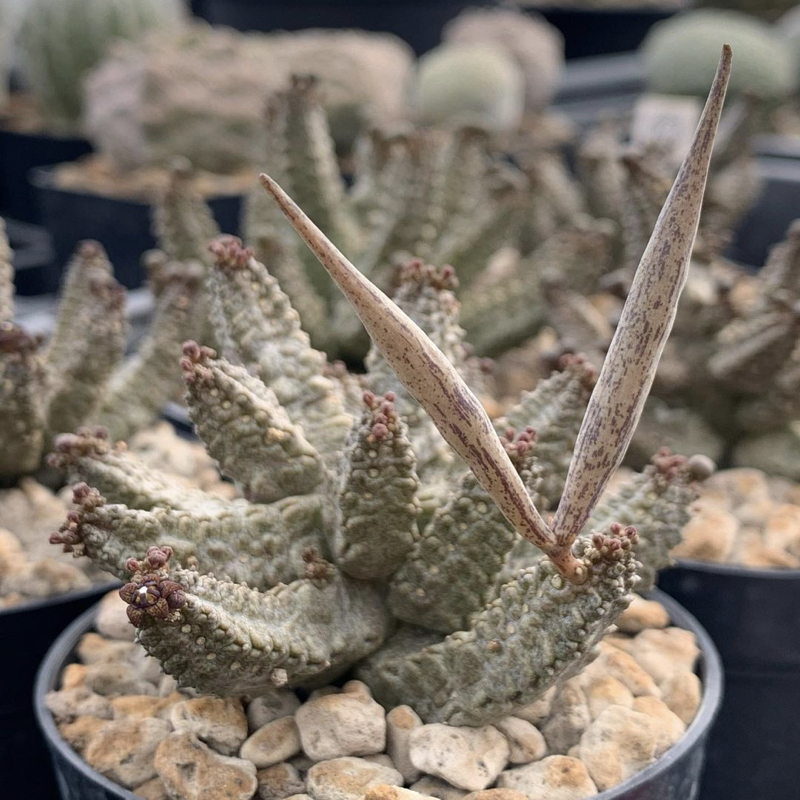 Pseudolithos mccoyi (Source)
Pseudolithos mccoyi (Source)
Pseudolithos mccoyi has elongated, cylindrical bodies. Unlike the compact or cube-shaped bodies of the other two species, Pseudolithos mccoyi features slender and elongated stems, often resembling fingers or sausages. The color of these bodies can be grey-green or brown.
Pseudolithos mccoyi produces star-shaped flowers like the other species, but the flower color can vary from yellow to pale maroon.
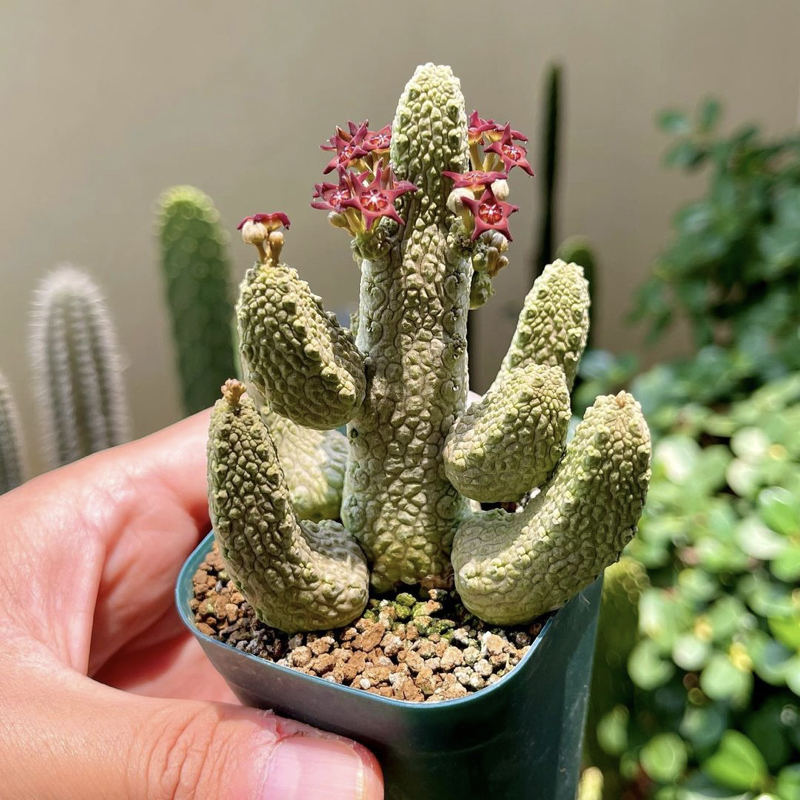 Pseudolithos caput-viperae (Source)
Pseudolithos caput-viperae (Source)
Pseudolithos caput-viperae is recognized for its distinct, unusual appearance. The plant consists of conjoined, stone-like bodies that are often described as resembling the head of a snake or viper. The bodies are typically grayish-green to brown and can have prominent tubercles.
The shape of the bodies of Pseudolithos caput-viperae is often compared to a snake's head, making it particularly unique and visually striking.
Similar to other Pseudolithos species, Pseudolithos caput-viperae produces star-shaped flowers. The color of the flowers can vary and typically ranges from yellow to pale maroon, depending on the specific plant and growing conditions.
The Appearance of Pseudolithos
Leaves
Pseudolithos is instantly recognizable by its striking, pebble-like appearance. The plant's succulent leaves are fused together, forming a singular, rock-like structure. These leaves are typically grey or green and may feature mottled patterns or tubercles, adding to their stone-like illusion.
Flowers
Pseudolithos produce peculiar, star-shaped flowers with a range of colors, from pale yellow to deep maroon. These blooms have a waxy texture and emit a peculiar odor that attracts the flies necessary for pollination.
How to Care for Pseudolithos
Light
Pseudolithos thrive in bright, indirect light. Placing them on a south or east-facing windowsill is ideal, as they require ample sunlight but should be protected from harsh afternoon sun.
Watering
One of the keys to successfully caring for Pseudolithos is to mimic their natural environment by providing minimal water. Allow the soil to dry out completely between waterings, and water sparingly, especially during the winter months.
Soil
Well-draining soil is crucial for Pseudolithos. A cactus or succulent mix that allows excess water to escape is ideal. Adding sand or perlite to the soil can enhance drainage.
Check out this video about how to care for Pseudolithos:
Temperature
Pseudolithos prefer warm temperatures and should be protected from cold drafts. They thrive in a range of 70-100°F (21-38°C).
Humidity
These succulents are well-suited to low humidity conditions and do not require extra moisture in the air.
Fertilizing
Fertilize sparingly during the growing season (spring and summer) with a diluted, balanced liquid fertilizer.
Pruning
Pruning is generally not necessary for Pseudolithos. Remove dead or damaged parts if needed.
Repotting
Repot your Pseudolithos when it outgrows its current pot or if the soil has become depleted of nutrients. Do this in the spring, and use a slightly larger pot with well-draining soil.
Dormancy
Pseudolithos have a natural dormancy period during the cooler months. Reduce watering during this time to simulate their native conditions.
Pests and Diseases
Pseudolithos are relatively pest-resistant but can occasionally fall victim to common succulent pests like mealybugs and aphids. Ensure proper care to prevent infestations.
Need tools for succulent propagation and repotting? Here are my go-to tools: mini tool set (including syringe 💉, gloves 🧤, tweezers 🪤, dust blower 💨, tiny shovels 🛠️) and well-draining mix 🌱.Is Pseudolithos Toxic to Pets?
Pseudolithos are generally considered non-toxic to pets, making them a safe choice for households with curious animals.
How to Propagate Pseudolithos
Pseudolithos can be propagated from seeds or cuttings. Seeds should be sown in well-draining soil, and cuttings should be allowed to callous before being planted in a similar mix. Propagation can be challenging, but with patience and the right conditions, it can be rewarding.
Where Can I Buy Pseudolithos?
Pseudolithos plants are not as widely available as some other succulents, but they can be found in specialty nurseries, online succulent shops, or through fellow plant enthusiasts.
FAQ
-
Are Pseudolithos easy to care for? Pseudolithos are relatively easy to care for, especially if you follow their natural habitat conditions, like minimal watering and well-draining soil.
-
How often should I water my Pseudolithos? Water sparingly, allowing the soil to dry out completely between waterings. In the dormant season, reduce watering even further.
-
Do Pseudolithos require special soil? Yes, they need well-draining soil, such as a cactus or succulent mix with added perlite or sand for improved drainage.
-
Can I grow Pseudolithos from seeds? Yes, Pseudolithos can be grown from seeds, but it can be a more challenging method compared to cuttings.



